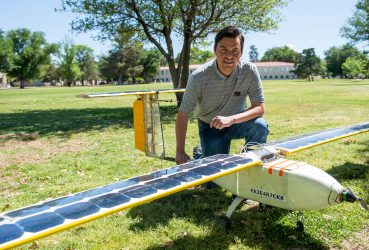DATE: 05/13/2019
WRITER: Tiffany Acosta, 575-646-3929, tfrank@nmsu.edu
CONTACT: Andreas Gross, 575-646-6179, agross@nmsu.edu
CONTACT: Jesus Rosales, 575-646-4413, rosales1@nmsu.edu
Model aircraft, which are also referred to as UAS, or unmanned aerial systems, could be used for rangeland and forest monitoring, and a research project in the College of Engineering at New Mexico State University is focused on increasing the endurance of such aircraft.
|

Jesus Rosales, a New Mexico State University mechanical engineering Ph.D. student, is leading a research project focused on increasing the endurance of unmanned aerial systems that could be used for rangeland and forest monitoring. (NMSU photo by Josh Bachman)
|
Through a combination of solar power and the utilization of atmospheric updrafts called thermals, a UAS could fly for several hours as opposed to the 30-minute flight time that a battery-powered aircraft offers.
Jesus Rosales, a mechanical engineering Ph.D. student, who is leading the project in the computational fluid dynamics lab explained how the aircraft will operate.
“The plane will climb using thermals, like soaring birds such as hawks or pilot-controlled sailplanes. While doing so it will recharge its battery by employing the sun’s energy. Then it will use the stored energy for electric propulsion to look for the next thermal,” he said.
Currently, the research team is working on improving the prototype aircraft and developing algorithms that emulate the skills of sailplane pilots. Rosales first began working on the project when he was a master’s student in fall 2016.
“The project was partially motivated by research at the Jornada Experimental Range about the use of UAVs for agricultural monitoring,” said Andreas Gross, mechanical engineering assistant professor and head of the computational fluid dynamics lab.
The journal article, “Unmanned aerial vehicle-based remote sensing for rangeland assessment, monitoring, and management,” published in 2009 by Albert Rango et al. in the “Journal of Applied Remote Sensing” has been a useful resource for the research team.
Advantages of using solar-powered UAS to monitor rangeland and forests include reduced costs compared to full-size airplanes and increased image quality because of the lower flight altitude. While occasional site visits by experts will still be needed, solar-powered UAS could take over the routine rangeland monitoring of plant growth, an important factor for livestock grazing, as well as routine forest moisture content measurements, which has implications for fire danger, according to Gross.
“Jornada showed us a multi-spectral camera,” Gross said. “Our airplane was designed around that camera. The flight characteristics of the aircraft were demonstrated successfully. We are currently working on improving the electrical system and developing flight control algorithms.”